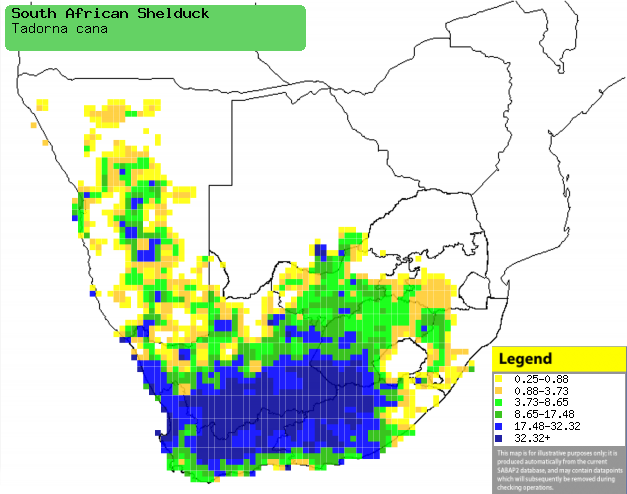|
Tadorna cana (South African
shelduck)
Kopereend [Afrikaans]; Lefaloa
(also applied to Egyptian goose) [South Sotho]; Grijskopcascara, Kaapse casarca
[Dutch]; Tadorne à tête grise [French]; Graukopf-rostgans [German];
Tadorna-africana [Portuguese]
Life
> Eukaryotes >
Opisthokonta
> Metazoa (animals) >
Bilateria >
Deuterostomia > Chordata >
Craniata > Vertebrata (vertebrates) > Gnathostomata (jawed
vertebrates) > Teleostomi (teleost fish) > Osteichthyes (bony fish) > Class:
Sarcopterygii (lobe-finned
fish) > Stegocephalia (terrestrial
vertebrates) > Tetrapoda
(four-legged vertebrates) > Reptiliomorpha > Amniota >
Reptilia (reptiles) >
Romeriida > Diapsida > Archosauromorpha > Archosauria >
Dinosauria
(dinosaurs) > Saurischia > Theropoda (bipedal predatory dinosaurs) >
Coelurosauria > Maniraptora > Aves
(birds) > Order: Anseriformes
> Family: Anatidae
Predominantly light chestnut coloured with a grey head
in the male and a grey head with variable amounts of white in the female. Endemic
to southern Africa, found mainly on waterbodies in semi-arid and grassland
regions. Feeds in the water on aquatic invertebrates and algae, and on land on
grain in crop fields.
Records
| Heaviest adult female |
1.84 kg |
| Heaviest adult male |
2.20 kg |
| Lightest adult female |
0.70 kg |
| Lightest adult male |
0.91 kg |
| Longest living |
13 yrs 11 months |
| Longest distance travelled |
1075 km |
Distribution and habitat
Endemic to southern Africa where it is found mainly
in Western Cape, Northern Cape, Free State, North West Province, Gauteng,
Namibia, south-eastern Botswana and southern KwaZulu-Natal. Prefers waterbodies with shallow
waters and exposed muddy shorelines, with low grassy or scrubby vegetation
round the perimeter. Distribution is also partly influenced by its highly
specialised nest site preference in vacated holes of aardvark and other
mammals that make large holes. As a result of these habitat requirements
it is mainly found on water bodies in semi-arid and grassland
regions. Its distribution is almost the direct opposite of the Comb
duck, which prefers tree-lined pans, lakes and rivers.
|
 |
|
Distribution of South African Shelduck in southern Africa,
based on statistical smoothing of the records from first SA Bird Atlas
Project (©
Animal Demography unit, University of
Cape Town; smoothing by Birgit Erni and Francesca Little). Colours range
from dark blue (most common) through to yellow (least common).
See here for the latest distribution
from the SABAP2. |
Call
Predators and parasites
- Predators (of chicks)
- Pelomedusa subrufa (Marsh terrapin)
- Pathogens
- Clostridium botulinum (Type C) causing
botulism
Food
Feeds both on land (mainly crop fields) and in the
water. Omnivorous with either animal or plant matter predominating in the
diet. The following food items have been recorded in its diet:
- Aquatic invertebrates:
- Crustacea
- Branchiopoda > Phyllopoda
- Notostraca > Apus numidicus
- Conchostraca > Caenestheriella
- Tendipedidae larvae and pupae
- Algae:
- Grain in crop fields:
Breeding
- Forms breeding pairs, which are territorial in the
breeding season. Pair bonds are thought to persist over more than one
season.
- The nest is made by the female in a pre-existing cavity
in the ground, most typically in an Aardvark (Orycteropus afer) burrow
(one nest was at the end of a 9 m long tunnel), but can also be in holes of
Springhares (Pedetes capensis) and porcupines
(Hystrix
africaeaustralis). They have also been known to nest among rocks and in a
haystack. Other than helping to hide away the nest (especially useful
because the the sparse vegetation surrounding the water bodies they like
inhabiting), nesting in burrows also helps to avoid the high temperatures
encountered in the semi-arid conditions above.
- Breeding season is from March to December, peaking from June to September.
- The female lays 6-15 eggs (usually 7-11) and the
incubation period (probably starting after clutch completion) is probably
for about 30 days (it has not been measured). Only the female incubates the
eggs while the male protects the territory by hissing loudly to inform the
female of potential predators.
- Both parents care for the young and drive off any
animals that vaguely look threatening - even herons and cormorants. Young
are able to fly by 70 days old and they leave the adults from 90-120 days
old.
Threats
Distribution has expanded (e.g. into Namibia and
south-eastern
Botswana) as a result of the construction of articificial waterbodies such
as farm dams.
References
-
Hockey PAR, Dean WRJ and Ryan PG (eds) 2005. Roberts
- Birds of southern Africa, VIIth ed. The Trustees of the John Voelcker
Bird Book Fund, Cape Town.
|
